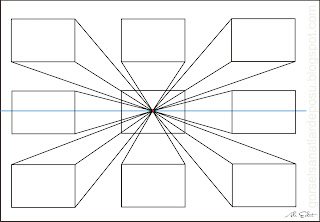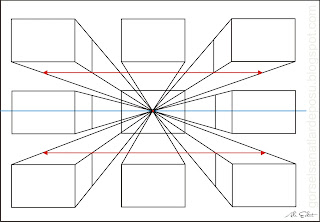The Technique of Perpective Drawing
Perspective Drawing is a technique used to represent three-dimensional images on a two-dimensional picture plane. In our series of lessons on perspective drawing we explain the various methods of constructing an image with perspective and show how these are used by artists and illustrators.
"Perspective is to painting what the bridle is to the horse, the rudder to a ship……………..There are three aspects to perspective. The first has to do with how the size of objects seems to diminish according to distance: the second, the manner in which colors change the farther away they are from the eye; the third defines how objects ought to be finished less carefully the farther away they are." (Leonardo da Vinci)
Perspective was developed in the 15th century by the architects, Leon Baptista Alberti (1404-72) and Filippo Brunelleschi (1377-1446). For 500 years, perspective drawing remained one of the basic principles of Western art until it was challenged by the ideas of the Cubists at the start of the 20th century. Whether you are working with conventional materials such as pencils and paints, or contemporary digital media, a knowledge and understanding of perspective drawing remains an essential tool to help you enhance your drawing technique.
There are two main elements in perspective drawing:
- Linear Perspective which deals with the organisation of shapes in space
- Aerial Perspective which deals with the atmospheric effects on tones and colours.
Brunelleschi mirror device
Alberti velo
Hogarth Satire on false pespective 1753Durer perspective machine
Alberti
de vries corinthia
Pietro Perugino's usage of perspective in this fresco at the Sistine Chapel (1481–82) helped bring the Renaissance to Rome.
Van Eyck
Crivelli
Boticelli
Caillebotte, Le balcon
Caillebotte
Vermeer -The music lesson-1662
Vermeer-The Courtyard of a House in Delft, 1658
Vermeer - The little street
Vermeer-Lady writing a letter her maid
Gustave Caillebotte -Paris Street, A Rainy Day (1877)
ATMOSPHERIC or AERIAL PERSPECTIVE
Aerial or atmospheric interference with visual perception causes loss of contrast, detail and sharp focus. The effect, which Leonardo called "the perspective of disappearance," tends to make objects seem to take on a blue-gray middle value as they increase in distance. This effect is used by film makers to give the illusion of great depth, but can be used to great effect by painters and draughtsmen.
Here is a list of attributes that objects have as they recede in space:
- SIZE OF OBJECTS-smaller objects seem farther away (distortions can occur if objects are the same size or too close to the viewer).
- OVERLAPPING OR SUPERIMPOSING-by partially covering one object with another it gives an appearance of depth (distortions also occur if viewer is too close).
- TEXTURE-density increases as an object gets further away.
- SPACING-objects clustered closer together seem farther away. Horizontal lines which get closer as they near the horizon line appear to be defining a recession in space.
- FOCUS-objects lose detail as they recede into space.
- BRIGHTNESS-objects are brighter when closer to the viewer, except for reflective surfaces.
- SHADE AND SHADOW-darker shadows seem closer especially if overlapping other shadows.
- UPWARD ANGULAR LOCATION-creates depth if juxtaposed to ground and sky lines, e.g. tall buildings.
- COLOR-color intensity is much greater closer to the viewer and tends toward medium gray as it recedes.
- Hint: As objects recede away from the viewer in atmospheric perspective, bright whites and rich blacks tend toward medium gray and eventually disappear into a blue/gray background. Even colors have greater intensity closer to a viewer than they do further away.
Linear Perspective
Perspective
There are two simple rules about representing depth. Size decreases with distance, meaning objects that are further away from the viewer appear to be smaller. Objects also overlap when one is in front of the other, hiding part or all of the farther object(s). These two observations are the basis for perspective.The easiest way to understand how perspective works is to imagine standing in the middle of train tracks (not recommended for safety reasons) and looking along the tracks into the distance. Visually follow the tracks to the horizon (where the earth meets the sky) and the tracks appear to meet at a point in the distance. This converging point is called the vanishing point.
Now imagine that as you look at the train tracks converge into the distance, you are holding a piece of rectangular glass directly in front of you. If you traced what you saw onto the glass with a marker, you would be drawing onto the picture plane. Perspective is a method for representing what is seen through the picture plane on another two-dimensional surface.
The train tracks are an example of one-point perspective, the easiest of the perspective methods. This method is useful when representing landscapes, city streets, and other environments in which things are aligned and converge to one central point.
Horizon line-is always at eye level. Picture yourself at the seashore and looking out at the ocean you notice that the water meets the sky at your eye level. This never changes. You may be in an airplane 1000 feet up and the level that the ocean meets the sky is still at your eye level! Or you may be lying down on the beach and the ocean level drops with you. Think of it as an invisible plane that cuts through everything, that always exists at eye level.
The Horizon is The Eye Level
The horizon / eye level is the axis around which a perspective drawing is constructed.
When we are outdoors we use the horizon as a point of reference to judge the scale and distance of objects in relation to us.
In perspective drawing, the horizon happens to be the viewer's eye-level.
In art, we tend to use the term 'eye level', rather than 'horizon' as in many pictures, the horizon is frequently hidden by walls, buildings, trees, hills etc.
Hint: Your horizon line always falls at eye level regardless of where you're looking. For instance, if you are looking down, your eye level remains at the height of your eyes, not down where you are looking.
Hint: If an object is directly in front of the vanishing point, only the front is visible and all sides are obscured.
ONE POINT PERSPECTIVE
One point perspective is so named because it uses a single vanishing point to draw an object
One-point perspective images have a tendency to draw the viewer along the lines to the vanishing point. This effect can be used to greater advantage by placing the subject of an image in front of or near the vanishing point. The viewers will more naturally focus their attention because most of the lines in the image converge onto that area. This effective technique has been used for centuries and can easily be seen in Leonardo da Vinci’s Last Supper and works from other artists.
Convergence Lines (also called orthagonals)-are lines that converge at the vanishing point. These are any lines that are moving away from the viewer at an angle parallel to the direction that the viewer is looking. In the case of the highway that we mentioned above these lines would be the edges of the highway as they move away from you forward into the distance.
Vanishing Point-is the point to which all lines which are parallel to the viewer recede. You may want to think of the last time you were looking down a long stretch of straight highway. The edges of that highway appear to move at an angle upward until they meet the horizon. In one point perspective all verticals and horizontals stay the same and only lines that are moving away from or toward the viewer seem to recede on the horizon at the vanishing point.
Two Point Perspective
Two-point perspective can be used to draw the same objects as one-point perspective, rotated: looking at the corner of a house, or looking at two forked roads shrink into the distance, for example. One point represents one set of parallel lines, the other point represents the other. Looking at a house from the corner, one wall would recede towards one vanishing point, the other wall would recede towards the opposite vanishing point.
Two-point perspective exists when the painting plate is parallel to a Cartesian scene in one axis (usually the z-axis) but not to the other two axes. If the scene being viewed consists solely of a cylinder sitting on a horizontal plane, no difference exists in the image of the cylinder between a one-point and two-point perspective.
Two-point perspective has one set of lines parallel to the picture plane and two sets oblique to it. Parallel lines oblique to the picture plane converge to a vanishing point,which means that this set-up will require two vanishing points.
Two point perspective uses two sets of orthogonal lines and two vanishing points to draw each object.
Three Point Perspective
Three Point Perspective is the most complex form of perspective drawing. Three point perspective uses three sets of orthogonal lines and three vanishing points to draw each object.This technique is most commonly used when drawing buildings viewed from a low or high eye-level.
Three-point perspective is usually used for buildings seen from above (or below). In addition to the two vanishing points from before, one for each wall, there is now one for how those walls recede into the ground. This third vanishing point will be below the ground. Looking up at a tall building is another common example of the third vanishing point. This time the third vanishing point is high in space.
Three-point perspective exists when the perspective is a view of a Cartesian scene where the picture plane is not parallel to any of the scene's three axes. Each of the three vanishing points corresponds with one of the three axes of the scene.















































































































































Hiç yorum yok:
Yorum Gönder